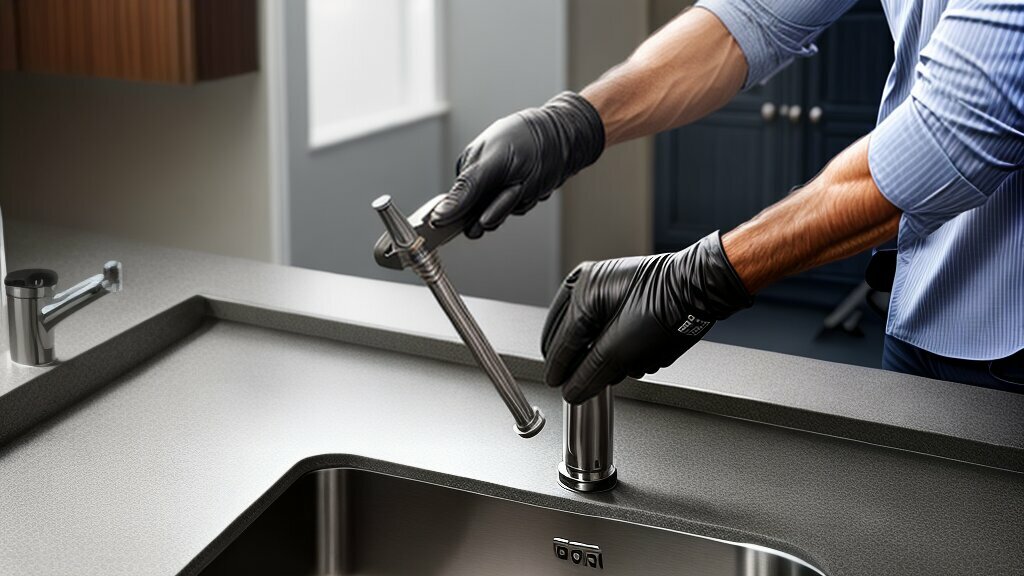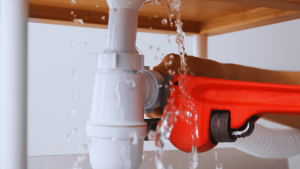If you are planning to renovate your kitchen, removing the old sink is one of the first steps you need to take. Removing a kitchen sink does not have to be complicated; with the right tools and guidance, you can do it yourself and save money on professional help. This article will provide easy-to-follow steps and tips on removing a kitchen sink safely and efficiently.
Key Takeaways
- Removing a kitchen sink is a necessary step for kitchen renovation.
- You can remove a kitchen sink yourself with the right tools and guidance.
- Proper preparation and caution are required for a successful DIY project.

Tools for Kitchen Sink Removal
Before starting the kitchen sink removal process, it is vital to have the proper tools on hand. Here are the essential tools you’ll need:
| Tool | Function |
|---|---|
| Adjustable wrenches | To loosen and tighten nuts and bolts |
| Channel-lock pliers | To grip and turn plumbing connections |
| Screwdrivers | To remove screws and other fasteners |
| Putty knife | To remove any caulk or adhesive around the sink |
| Utility knife | To cut through caulk or adhesive if necessary |
In addition to these tools, we recommend having a bucket, towels, and lubricant on hand to help with any stubborn connections or difficult situations that may arise.
With these tools, you’ll be well-equipped for a successful kitchen sink removal project.
Preparing for Kitchen Sink Removal
Before beginning the kitchen sink removal process, taking the necessary precautions and preparations is essential to ensure a successful project. Here are the steps you should follow:
- Please turn off the water supply: Locate the water valves under the sink and turn them off. You must turn off the main water supply if there are no valves.
- Clear the area: Remove any items under and around the sink to create a clear workspace. This will also prevent any tools or parts from getting lost or damaged.
- Disconnect plumbing connections: Use wrenches or pliers to disconnect the links attached to the sink. Ensure a bucket or towel is handy to catch any spillover water.
Following these preparation steps, you can proceed with the kitchen sink removal process quickly and efficiently. Remember to take your time and exercise caution to avoid damage or accidents.
Step-by-Step Kitchen Sink Removal Guide
Follow these easy steps to remove your kitchen sink:
- Step 1: Switch off the water supply: Before commencing the process, turn off the water supply to the sink. Locate the shut-off valves beneath the sink, or shut off the water supply to the entire house if needed.
- Step 2: Clear the area: Remove any clutter or items around the sink to ensure an unobstructed workspace.
- Step 3: Disconnect the plumbing connections: Use pliers to loosen and disconnect any plumbing connections. This may include the drainpipe, water supply lines, and dishwasher hose.
- Step 4: Loosen the mounting clips: Locate the mounting clips underneath the sink and use a screwdriver or wrench to loosen them. Once they are reduced, the sink should be lifted out of the countertop.
- Step 5: Lift the sink out: Carefully lift it from the countertop, ensuring it is disconnected from any remaining plumbing connections.
Step 6: Prepare for disposal: Once the sink is removed, clean it thoroughly and prepare it for safe disposal. This might entail breaking it down into more manageable segments, disposing of it in a designated waste bin, or transporting it to a nearby recycling facility. Dismantling a kitchen sink can seem overwhelming, particularly for those new to the process. However, by following this step-by-step guide, you can ensure a successful removal process in no time!
Tips for Easy Kitchen Sink Removal
Extracting a kitchen sink might appear intimidating, yet we’re here to assist in simplifying the process for you! Here are some expert tips and tricks to help you successfully remove your kitchen sink:
- Turn off the water supply: Before removing the sink, Ensure to turn off the water supply to avoid the risk of water damage or flooding.
- Clear the area: Clear out any clutter or appliances from the area around the sink to give yourself more space to work.
- Enlist a friend: Kitchen sinks can be heavy and awkward to remove, so having a friend assist you can make the job much smoother.
- Use lubricant: For stubborn connections, use a lubricant such as WD-40 to make loosening them easier.
- Label plumbing connections: It’s essential to label the plumbing connections so you know which ones to reconnect when installing a new sink.
- Be patient: Proceed comfortably and work deliberately to prevent any harm to components or the risk of leaks.
Keep in mind safety comes first! Always wear gloves and safety glasses when you’re involved in plumbing projects.
By following these tips, you can remove your kitchen sink with ease and confidence.
Dealing with Old or Rusty Sink Components
While removing a kitchen sink can be straightforward, dealing with old or rusty components can get tricky. Here are some tips to make it easier:
- Use lubricant: If any bolts or nuts are stubborn, apply a lubricant like WD-40 to help loosen them.
- Substitute worn components: If you identify any parts that appear damaged or deteriorated, replacing them while removing the sink is advisable. This way, you can avoid the need to address them later on.
- Seek professional help: If you need help dealing with old or rusty sink components, feel free to seek professional help. A plumber can help you navigate tricky situations and prevent damage to your plumbing system.
By adhering to these guidelines, you can avoid prevalent challenges when dismantling a kitchen sink with aged or corroded components.
Cleaning and Disposing of the Old Sink
After successfully removing the old kitchen sink, cleaning and disposing of it is essential. Please do so to avoid clutter and safety hazards in your workspace. Here’s how to do it:
- Scrub the Sink: Employ a cleaning solution and a scrub brush to eliminate dirt, grime, or food particles from the sink’s surface. Be sure to clean both the inside and outside surfaces of the sink.
- Rinse the Sink: After scrubbing, rinse the sink with water to eliminate any residual cleaning solution.
- Dry the Sink: Use a clean towel or rag to dry the sink thoroughly.
- Dispose of the Sink: Depending on local regulations, you can dispose of the old sink with your regular trash pickup. If you require assistance, contact your local waste management company to coordinate appropriate disposal.
Properly cleaning and disposing of your old sink ensures a clean and clutter-free workspace for your kitchen sink replacement project.
Replacing the Kitchen Sink (Optional)
If you’ve decided to replace your old kitchen sink, measuring the dimensions of the existing sink and the countertop cutout is essential to ensure a proper fit. Next, browse your options at a local hardware or home improvement store and select a sink that fits your design preferences and needs.
Once you have your new sink, you will need to follow the manufacturer’s instructions for installation. This typically involves positioning the sink in the countertop cutout and securing it with mounting brackets or clips. Then, you must reconnect the plumbing, including the drain pipes and water supply lines.
If you are unfamiliar with plumbing or installing sinks, it is advised to seek professional help to avoid any mishaps or damage to your plumbing system.
Troubleshooting Common Issues
While removing a kitchen sink is a relatively straightforward process, a few common issues may arise. Here are some troubleshooting tips to help you overcome these challenges:
- If the mounting clips or screws are stuck or difficult to loosen, try applying some lubricant to help loosen them up. You may also want to use pliers or a wrench to reduce the clips.
- If you encounter a leak or damage to the drainpipe or other plumbing components, you may need to replace these parts before reinstalling the sink. Consult a plumber or hardware store for advice on the best replacement parts.
- If you encounter rust or corrosion on any of the sink components, such as the mounting clips or drainpipe, you may also need to replace these parts. Again, consult a plumber or hardware store for the best replacement parts.
- If you’re encountering difficulty detaching the plumbing connections, consider using a pair of pliers to loosen the nuts. You may need a specialized plumbing tool for extra leverage if the nuts are too tight.
- If you encounter any electrical connections, such as a garbage disposal, turn off the power before disconnecting the wires. If you need help doing this safely, consult an electrician.
- If you encounter any other issues or difficulties during removal, don’t hesitate to seek professional help. A plumber or handyman can provide expert guidance and assistance if needed.
By adhering to these troubleshooting suggestions, you can surmount typical challenges and successfully execute the process of kitchen sink removal with confidence.
Conclusion
Congratulations! You have successfully learned how to remove a kitchen sink in just a few easy steps. Before starting the removal process, preparing the area properly and gathering all necessary tools is essential. Once you’ve successfully removed your kitchen sink, you can proceed to fix any plumbing issues that may arise, ensuring that your kitchen remains functional and free from leaks or blockages.
If you encounter any issues during the removal process, don’t panic. Our troubleshooting section provides tips and solutions for problems such as stubborn connections, leaks, and damaged components.
Finally, we encourage you to dispose of the old sink properly and clean the work area. If you plan on replacing the sink, follow the steps for selecting and installing the new one.
Expert Help
Remember, if you encounter any issues or feel uncomfortable with the removal process, seek professional help. Removing a kitchen sink may seem simple, but it can be more complicated than anticipated.
Thank you for following our step-by-step guide on how to remove a kitchen sink. Happy DIY-ing!
FAQ
Q: How do I remove a kitchen sink?
A: To remove a kitchen sink, follow these easy steps for a successful DIY project.
Q: What tools do I need for kitchen sink removal?
A: Essential tools for kitchen sink removal include wrenches, pliers, screwdrivers, and more.
Q: What preparations should I make before removing the kitchen sink?
A: Before removing, turn off the water supply, clear the area, and disconnect any plumbing connections.
Q: Can you provide a step-by-step guide for kitchen sink removal?
A: Certainly! Follow this detailed, step-by-step guide to remove your kitchen sink with ease.
Q: Are there any tips for making kitchen sink removal easier?
A: Yes! Use lubricant on stubborn connections, and consider enlisting the help of a friend for a smoother process.
Q: How do I deal with old or rusty sink components?
A: If you encounter old or rusty sink components, we’ll provide solutions and guidance on navigating these situations.
Q: How can I clean and dispose of the old sink properly?
A: We’ll provide instructions on cleaning and safely disposing of the old sink, ensuring a clean and clutter-free work area.
Q: Can you briefly explain how to replace a kitchen sink?
A: If you want to replace your kitchen sink, we’ll touch on the steps and provide additional resources for a comprehensive guide.
Q: What are some common issues during kitchen sink removal, and how do I troubleshoot them?
A: We’ll address common issues like stubborn connections, leaks, or damaged components, offering troubleshooting tips and solutions.

It’s me, Amber Hayden, the heart and soul behind SagarmathaOnlineMedia.com. From a young age, I’ve been head over heels for everything home-related, from interior decor to gardening. I’m the type who can’t resist a well-crafted piece of furniture, and I firmly believe that a home isn’t complete without a pet or two. But it’s not just about creating pretty spaces for me. I’m all about making homes that tell a story reflecting the people living there. SagarmathaOnlineMedia.com is my way of sharing this passion with you. Whether you’re looking for tips to jazz up your living room, advice on pet care, or ideas to make your garden bloom, I’m here to help. So, let’s embark on this journey together and make your house a home!



